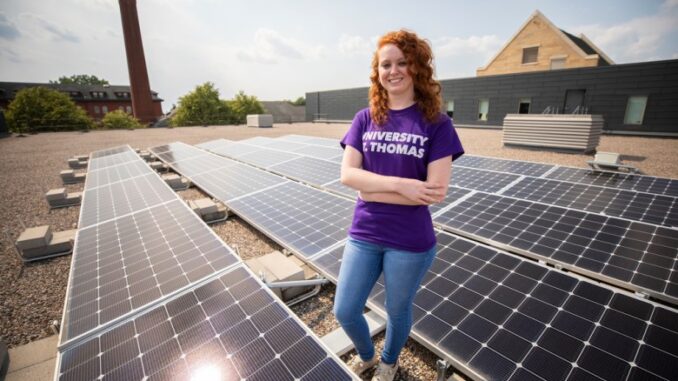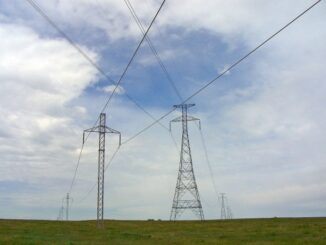
A St. Paul, Minnesota, college’s microgrid research center is preparing to expand after securing significant new state and federal funding.
The University of St. Thomas’ Center for Microgrid Research plans to triple its three-person staff and enroll more students thanks to money from a $7.5 million state legislative appropriation and $11 million in federal defense bill earmarks secured by U.S. Rep. Betty McCollum.
State officials who championed the funding said they hope the center’s education and research efforts can help train future grid technicians and smooth the state’s path to 100% clean electricity by 2040.
“We’re at a time of not only a great transition but of a great opportunity,” said state Sen. Nick Frentz, a Democrat from Mankato. “We’ll be looking at transmission, distributed generation and innovation as we transition, and funding for the St. Thomas microgrid research is a part of the state’s plan to lead.”
Microgrids are small, hyperlocal networks of electricity generation and storage systems that together can operate independently of the rest of the power grid. They’re often used by military, healthcare or research campuses that require a level of reliability greater than what the local utility can provide.
But they’re not just expensive backup power for wealthy institutions. Microgrids are also expected to play a role in the clean energy transition, helping to get the most value out of clean energy investments and connecting customers to one another in new ways.
“Microgrids are another opportunity for clean energy,” said John Farrell, co-director of the Institute for Local Self-Reliance and director of the Energy Democracy Initiative.
Microgrids could help balance variable power sources such as wind and solar, helping to absorb and store surplus generation and share it with the grid later when it’s needed, Farrell explained. While microgrids can be powered by fossil fuel backup generators, they also can run on solar panels, whose value can be greater when they are networked with arrays on multiple sites.
Electrical Engineering student Rachel Pietsch poses for photos by the microgrid center’s solar panels on the rooftop of the campus gym. Credit: University of St. Thomas / Courtesy
The University of St. Thomas has been developing its campus microgrid for about a decade. Today, it consists of a 48-kilowatt rooftop solar array along with a diesel generator, a lead acid battery pack, and an inverter that converts direct current to alternating current. A campus substation connects to Xcel’s local grid.
Like most microgrids, the St. Thomas system can run in “island” mode, meaning it can operate even when the power grid fails by drawing on the battery, solar panels and backup generation.
The Center for Microgrid Research opened in 2020 as a way to build research and education programming around its campus microgrid. Mahmoud Kabalan, the center’s director, was hired in 2017 from Villanova University to teach engineering and helped secure seed funding from Xcel Energy’s Renewable Development Fund for the program.
Don Weinkauf, the school’s dean of engineering, said the new state and federal funding will allow the center to expand both the program and the microgrid system itself.
“This stuff is expensive,” Weinkauf said. “Each piece of equipment is on the scale of a million dollars, and right now, we are expanding to reach a 1-megawatt capacity.”
The center will have 10 full-time employees next year and be able to enroll up to 25 students. More staff and students will allow more collaboration with utilities, corporations, and fellow researchers. Within the next few years, the microgrid will connect to more than five buildings, including a new science, technology and arts center, dorms and a parking facility.
Kabalan said he expects more funding from the U.S. Department of Defense, which sees the program as a workforce training ground and source of applied research to help design, test and implement microgrid technologies.
“This funding will position the state and the nation to produce innovative engineers that can address the need for microgrids and distributed energy technologies,” Kabalan said. “A big part of what we do is educate and train engineers.”
The center is collaborating with the U.S. Army Corps of Engineers on a military initiative to install microgrids at every military base by 2035, Kabalan said. Research related to that project will be publicly available to other microgrid operators and researchers. Students and faculty have other clients and supporters, including utilities Xcel Energy and Connexus Energy.
Part of the center’s design and strategy has been to serve as a place where clients can test how their equipment works in a microgrid. The technology available includes test bays to plug in products, controllers, relayers and emulators capable of creating simulated environments.
“Interested parties can literally roll in their equipment and we can test their technology at full scale,” Weinkauf said. “This is an industry-friendly center that can help us, and the state of Minnesota, navigate our future grid.”
Students like the hands-on quality of the microgrid center. Engineering student Oreoluwa John Ero, a research assistant at the center, has helped develop models to attach the new STEAM building to the university’s microgrid.
“I like the ability to see and practice the different things you learn in school and the chance to learn while on the job,” Ero said.
Utility industry professionals who have visited the center also like the hands-on approach. Connexus Energy engineering and system operations director Jared Newton said the center “immediately resonated with me because I saw students learn on real-world equipment that we use. The problems they were trying to solve and the tools they were using were familiar.”
As climate change and aging infrastructure make weather-related power outages more common, Kabalan thinks microgrids will become more common for critical infrastructure such as hospitals, prisons, data centers, food storage areas, cooling centers and government facilities.
Ero sees how the microgrid could transform the power grid in the United States and in his home country of Nigeria, where electricity outages are common and can last for hours and weeks.
“It’s a technology that should be made available to people,” Ero said, “not just in Nigeria, but all over the world.”



